

The recalcitrance of cellulosic matter has been an active area of research for sometime that has intensified as part of the Department of Energy's Biomass program. To that end, how many people can comment on the wide variety of approaches that can be taken to investigate recalcitrance? Pretreatment processes are accepted required steps in overall fermentative biomass process schemes.
To help demystify the challenge of recalcitrance, a friend of mine with a significant amount of petroleum industry experience provided the following comparison. Certain straight chain hydrocarbons are relatively easy to crack over catalytic surfaces (i.e. heat to temperatures where resultant smaller products are thermodynamically favorable); such processes can be manipulated in relatively well understood fashion. However, larger molecular weight crude feeds can be problematic when passed over catalytic surfaces (spoiling them). Part of the reason for this observation is in part due to the physical (e.g. branched) nature of the feed compounds. My friend explained that a simple view of petroleum feeds can be thought of as straight sticks and spider webs, the sticks can be easier (to process) whereas spider webs can cause a multitude of problems, again, partially due to chemical structure.

Similarly, in cellulosic feed stocks, there are physical similarities to petroleum feed stocks, however, in cellulosic feeds stocks the "sticks" and "spiderwebs" occur in a combined packages. Glycan (sugar containing) structures are both linear and branched in nature. However, complication arises because glycan structure is bound by proteinaceous matter as well as by lignin. Lignin for example, has several patterns of monomer units (three types of cinnamyl alcohol derivatives) and at best, might be considered a multi-block co-polymer. The sum of these entangled compounds forms larger super structures that give rise to the integrity of cell walls and thus, the perceived recalcitrance.
Pretreatment methods are applied to biomass to reduce recalcitrance of sugar moieties (e.g. the application of fungi). Further specified, lignin is one component that can be "deconstructed" by fungi that have been found to perform this task via oxidative mechanisms apposed to strict hydrolytic means. Further, fungi do not typically utilize lignin as a primary carbon source but metabolize lignin to carbon dioxide. A specific biologic agent of lignin destruction found in fungi is lignin peroxidase. Lignin peroxidase has been shown to be capable of several reactions, some of which include: a-b cleavage, a-oxidation, aromatic ring cleavage, aryl dealkylation, and O-C4 cleavage.
Finally, galvanotropism is the recognition of a directed and neuronal based growth pattern in an electrical field. Fungi and their associated hyphae have been observed to orient themselves in patterns but vary with from species to species and have been shown to be dependent upon the type of buffered medium they are grown upon. Fungi based pretreatment remains as one of the active areas of biomass based research.


